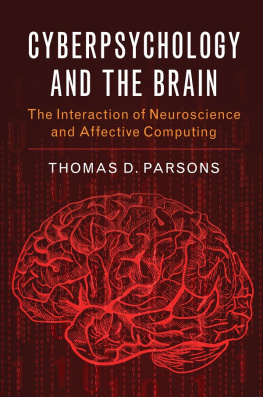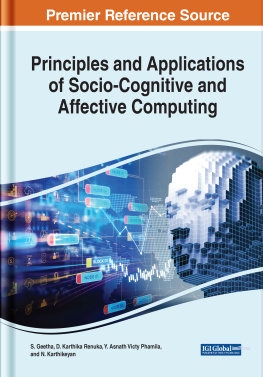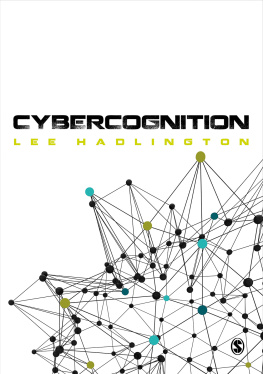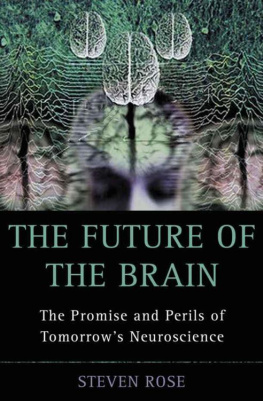Cyberpsychology is a relatively new discipline that is growing at an alarming rate. While a number of cyberpsychology-related journals and books have emerged, none directly address the neuroscience behind it. This book proposes a framework for integrating neuroscience and cyberpsychology for the study of social, cognitive, and affective processes and the neural systems that support them. A brain-based cyberpsychology can be understood as a branch of psychology that studies the neurocognitive, affective, and social aspects of humans interacting with technology, as well as the affective computing aspects of humans interacting with computational devices or systems. As such, a cyberpsychologist working from a brain-based cyberpsychological framework studies both the ways in which persons make use of devices and the neurocognitive processes, motivations, intentions, behavioral outcomes, and effects of online and offline use of technology. Cyberpsychology and the Brain brings researchers into the vanguard of cyberpsychology and brain research.
Thomas D. Parsons , PhD, is Associate Professor of Psychology at the University of North Texas. He has also served as Assistant Professor and Research Scientist at the University of Southern Californias Institute for Creative Technologies. He is a leading scientist in the integration of neuropsychology and simulation technologies. He has directed 17 funded projects and been an investigator on an additional 13 funded projects. In addition to his patents for eHarmony.coms Matching System, he has invented and validated virtual realitybased neuropsychological assessments. He has more than 200 publications and has been awarded the National Academy of Neuropsychologys Early Career Achievement award.
Thomas D. Parsons
University Printing House, Cambridge CB2 8BS, United Kingdom
One Liberty Plaza, 20th Floor, New York, NY 10006, USA
477 Williamstown Road, Port Melbourne, VIC 3207, Australia
4843/24, 2nd Floor, Ansari Road, Daryaganj, Delhi 110002, India
79 Anson Road, #0604/06, Singapore 079906
Cambridge University Press is part of the University of Cambridge.
It furthers the Universitys mission by disseminating knowledge in the pursuit of education, learning, and research at the highest international levels of excellence.
www.cambridge.org
Information on this title: www.cambridge.org/9781107094871
DOI: 10.1017/9781316151204
Thomas D. Parsons 2017
This publication is in copyright. Subject to statutory exception and to the provisions of relevant collective licensing agreements, no reproduction of any part may take place without the written permission of Cambridge University Press.
First published 2017
Printed in the United States of America by Sheridan Books, Inc.
A catalogue record for this publication is available from the British Library .
ISBN 978-1-107-09487-1 Hardback
ISBN 978-1-107-47757-5 Paperback
Cambridge University Press has no responsibility for the persistence or accuracy of URLs for external or third-party Internet Web sites referred to in this publication and does not guarantee that any content on such Web sites is, or will remain, accurate or appropriate.
I dedicate this book to a monkey, a bearcat, a bugaboo, and a beagle. Together we make a family.
Contents
Figures
Tables
Preface
While cyberpsychology is a relatively new discipline, it is one that is growing at an alarming rate. Perhaps this is due to the fact that humans are witnessing a time of rapid progress in an increasingly connected world. As a result, we have seen the emergence of a number of cyberpsychology-related societies, conferences, journals, and academic-level texts. Interestingly, none of these academic journals or books on cyberpsychology directly addresses the rapid progress in neuroscience. There are now dozens of laboratories around the world that have converged to investigate neurocognitive, affective, and social questions. While there is a great deal of work in cyberpsychology that deals with neural correlates of persons interacting with technology and neuroscientific investigations of cyberpsychology issues, there is no text that pulls together this material for cyberpsychologists. This book is a first attempt at bringing together this information for researchers and students in cyberpsychology.
To encourage the inclusion of brain science research in the cyberpsychology domain, this book proposes a framework for integrating neuroscience and cyberpsychology for the study of social, cognitive, and affective processes and the neural systems that support them. Given these emphases, a brain-based cyberpsychology can be understood as a branch of psychology that studies (1) the neurocognitive, affective, and social aspects of humans interacting with technology and (2) affective computing aspects of humans interacting with devices/systems that incorporate computation. As such, a cyberpsychologist working from a brain-based cyberpsychological framework studies both the ways in which persons make use of devices and the neurocognitive processes, motivations, intentions, behavioral outcomes, and effects of online and offline use of technology. Research in a brain-based cyberpsychology framework ranges from studies with offline platforms (using desktop computers, word processors, virtual/augmented reality, gaming consoles, and statistics packages), to online Internet use (how we engage in online banking, shopping, dating, and gaming), to mobile phones. These studies emphasize the study of neurocognitive, affective, and social processing behaviors in relation to the ways in which persons use and communicate via technological devices. Cyberpsychologists view these devices as tools that either facilitate or impede human interaction and communication.
Cyberpsychology has a lot to offer human neuroscience research. Specifically, there is increasing acknowledgment among social, cognitive, and affective neuroscientists that there is a need to move beyond the static stimulus presentations found in their investigations of human neurocognition. While many of the pioneering paradigms in the human neurosciences reflected a noteworthy emphasis on laboratory control and experiments that involve participants observing static stimuli that are devoid of interactions, there are increasing questions about whether knowledge gained using these static stimuli will generalize to the social, cognitive, and affective processes found in everyday activities. Cyberpsychologists can aid these neuroscientists by introducing them to the more ecologically valid scenarios found in cyberpsychology simulations (e.g., virtual and augmented reality).
In addition to the positive impact that cyberpsychology stimuli and platforms can have on the human neurosciences, there is a great deal that cyberpsychology can gain from the cognitive, affective, and social neurosciences. While neuroscientific research is highlighted throughout this book, many of the examples provided reflect assessments of behavioral performance. Although it can be challenging to operationalize the extent to which a stimulus approximates activities of daily living, this book gives examples of stimuli and virtual environmentbased contexts that span the implied continuum. The studies reviewed in this book are not meant to be exhaustive. Instead this review focuses on cyberpsychology research that highlights the ways in which persons respond to clinical, affective, and social stimuli in simulations that approximate real-world activities and interactions.
















